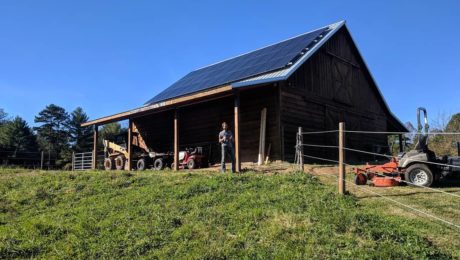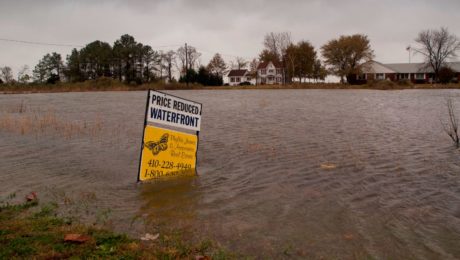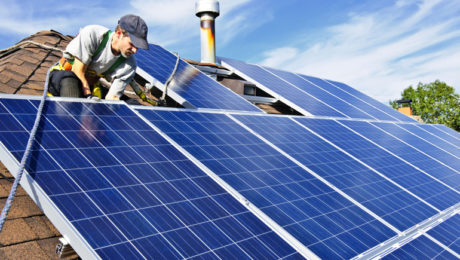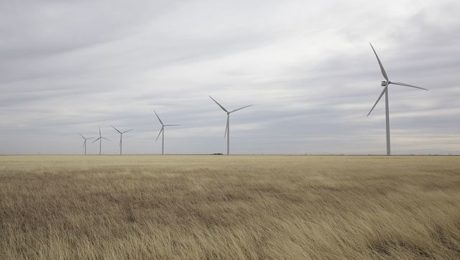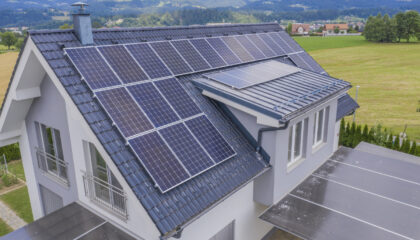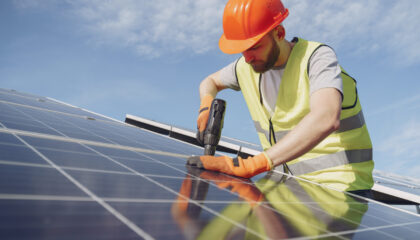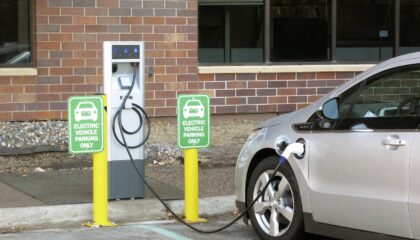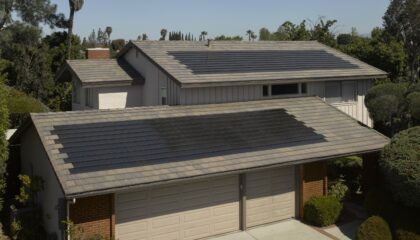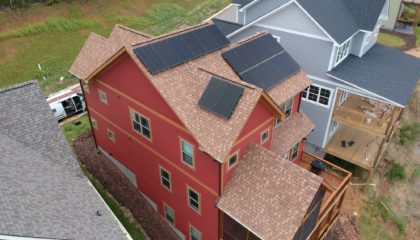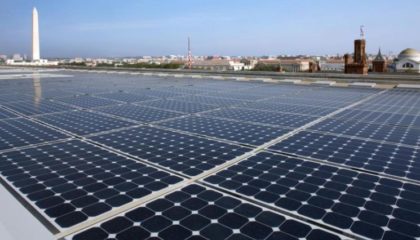USDA Grants & Loans For Renewable Energy & Energy Efficiency
With all the recent talk about the Duke Energy solar rebate there has been little highlighting of funding available for rural businesses and agricultural producers provided by the United States Department of Agriculture. Small businesses in rural areas and many agricultural producers are eligible for guaranteed loans and unrestricted grants to help finance energy efficiency programs. To see if your business is located in a designated rural zone click here.
There are no location restrictions on agricultural producers if 50% of their gross income comes from agricultural operations.
USDA currently offers grant funding up to 25% of the total cost of a project and loans funding up to 75% of the total cost of a project. This program makes achieving energy efficiency for small and rural businesses an attainable goal. This funding may be applied not only to solar energy systems but to hydro-power, wind generation, biomass, and high efficiency HVAC systems.
The goal of this program is to increase energy supply from the private sector and provide more independence for people located further from big energy hubs. Taking large demands off the grid brings down demand and cost for everyone while also providing jobs to local alternative energy installers.
Similar to the Duke Rebate, there are deadlines to apply for these incentives. Click here for the official North Carolina USDA website for details about eligibility, deadlines, and financial statistics about these loans. The South Carolina USDA webpage can be found here.
Give us a call and we can tell you if your company qualifies for a USDA grant and/or loan for your solar energy project.
- Published in Solar Energy, Solar News
Coastal Flooding Projected To Rise
A June 2018 study released by the Union of Concerned Scientists, regarding chronic coastal flooding, projects that flood levels will rise drastically within the next 30 years directly caused by rising sea levels due to increasing carbon emissions.
Already many areas are seeing routine coastal flooding that did not used to occur as recently as 1970. Although this has been an inconvenience, it has not become a major problem… yet. According to this study, by 2045 over 300,000 homes valuing roughly $117.5 billion dollars are at risk of constant flooding. These homes provide shelter for about 550,000 people and provide the country with nearly $1.5 billion a year in property tax revenue. In addition, there are 14,000 commercial properties valued at $18.5 billion that would be affected.
If these projections of chronic flooding aren’t correct, these homes will lose much of their value, become difficult to insure, and eventually be unlivable altogether. This huge change would create regional marketing crises, as well as negatively impact local real estate investors and bankers.
Although the effects climate change will have on our society are scary, it is important that we are staying diligently aware so that we can make changes, within our power, to slow the process. Clean energy is a huge factor in reducing carbon emissions and can easily be done on an individual level. Average residential homes powered with a solar system will prevent 5,760 pounds of carbon dioxide pollution a year from entering the atmosphere. Making sure we are using energy efficient appliances and vehicles are other steps we can personally take to slow the rapid effects of climate change.
To see specific data about flooding projections you can view this interactive map.
- Published in Climate Change, Solar Energy
Solar Tariffs Less of a Threat Than First Predicted
After President Trump approved the solar panel tariff earlier this year, prospects for the American solar industry were not the brightest. However, those predictions may prove to be false.
Having employed more than 250,000 Americans in 2017, the solar industry has seen tremendous growth in the last decade with a small decline in 2017. The solar panel tariff, while attempting to protect American solar panel manufacturers, put the larger part of the solar industry at risk. Manufacturing in Asia is simply cheaper than manufacturing in America, regardless of product or protections. With tariffs raising the price of solar panels imported from China to aid American solar panel manufacturers, solar panels became an option less people could afford. For solar installers, the shrinking pool of potential customers is not ideal. The tariffs created a sizable setback of 2018 solar installation projects.
However, the effect of the solar panel tariff may not be as extreme as some feared. China committed to renewable energy and remain committed; production of Chinese solar and wind energy has only increased. In fact, within the country, they have begun transitioning solar and wind from subsidies to auction, effectively proving that in a country dedicated to lessening its dependence on fossil fuels, renewables can be economically competitive without government interference.
Solidly focused on solar, China has already managed to lower production time and cost between the time the tariffs were put in place and today. The tariffs may be a short-term benefit to American solar panel manufacturers, but even with the tariffs, that benefit will not last. As China pulls subsidies from wind and solar, the Chinese solar panel market will become more competitive than it already is by increasing efficiency and decreasing cost.
The solar panel tariff temporarily wounded the American solar industry, but it was not a fatal blow. Solar energy technologies will consistently decrease is cost as time goes on and the solar industry will thrive because of it.
- Published in Policy, Solar Energy, Solar News
Trash to Solar
As the need to distance ourselves from fossil fuels becomes more urgent due to climate change and pollution in general, solar power is emerging as a leading alternative. It can be scaled to be used by individuals or large utilities; and best of all- it’s renewable. However, large scale solar farms require large tracts of land that have long and regular periods of sunlight. Suitable areas can usually be found in many rural settings and deserts, but transferring that energy over lengthy power lines to more populated areas can be expensive and inefficient.
A new trend is emerging that seems like a promising answer to this inconvenience – building on retired landfills! When a landfill is full it is covered with a polyethylene cap, a thin layer of soil, and finally grass. Despite it’s more pleasing aesthetics, this brownfield ground is still mostly unusable as it is unstable and not suitable for building large structures. Because of the gasses and toxins emitted by the covered landfill the growing of crops is also not a viable option. However, this acreage is perfect for large scale solar farms. Ballasted anchors are used to stabilize the solar array to avoid penetrating the landfill cap. This specialized racking system allows for thousands of solar panels to be installed on this otherwise unusable land; producing a lot of clean, renewable energy.
Landfills are typically built outside of, but close to, city limits and already have access to the power grid. This makes transporting energy for use in more densely populated areas much easier. Right now, there is an estimated 10,000 capped landfills in the US alone, and that number is only growing. The construction of large solar farms would not only positively impact the environment, it would create thousands of well-paying and sustainable jobs on land that is otherwise sitting unused.
- Published in Climate Change, Solar Energy, Solar News, Solar Technology
Solar Trumps Coal Environmentally and Economically
In a competitive market, coal is more expensive than both solar and wind.
In 2001, Texas created a competitive electricity market in that the least expensive resources go on the grid first. At that time, wind supplied less than one percent of Texas’ energy. As of 2018, 20 percent of the market is wind power. With technology and increased production lowering the cost of renewables, there are less arguments, than ever before, for the steady destruction of mountainous landscapes created by America’s need for coal.
Due to the competitive market, Texas has retired coal-fired plants, replacing them with natural gas which is significantly less expensive. By the end of next year, wind is expected to generate more electricity for Texans than coal as more plants are retired. However, these retired plants are largely being replaced by more efficient and less expensive natural gas plants. While natural gas beats coal in an environmentally-friendly competition, it is still a fossil fuel.
Texas’ competitive electricity market creates a fairer fight between renewables and fossil fuels when compared to other state and federal energy policies. Still, fossil fuels have an advantage. The hidden costs related to fossil fuel use like the consequences of climate change, explosions during drilling, transportation, spills and leaks, or burning process, and the pollution of land surrounding gas wells, is not included in the price comparisons of natural gas and renewables.
However, there is still hope. As we continue to burn the finite source of natural gas, it will face the same, inevitable dilemma of oil and coal. The low hanging fruit will be harvested, and the remaining sources will be difficult, dangerous, and expensive to gather while the cost of renewable energy continues to plummet. Someday, the market will favor it.
Will the invisible hand of the free market move soon enough? Don’t wait to see. Ease America’s dependency on fossil fuels by making a personal change in your energy source. Contact SolFarm Solar Co to see what you can do to save the planet.
- Published in Climate Change, Policy, Solar Energy, Solar News, Solar Technology
Energy Consumers Can Help Save the Earth Too
California began a program using the app OhmConnect. The app notifies residents signed up for the program when to turn off and unplug everything consuming energy. Not only are residents helping grid operators manage a grid becoming more and more reliant on renewables, they get paid for it.
Why?
Most of the strategies for lowering fossil fuel use consist of replacing fossil fuels with another energy source. However, solutions also lie with consumers of energy. Lowering consumption decreases the amount of energy required of the energy plants.
Transferring a grid from fossil fuels to renewables lowers the reliability of the baseload. The baseload is the minimum amount of energy a power plant generates to provide for their customers. It is easy to maintain a baseload with fossil fuels. Just burn however much the area needs, increasing the amount of coal, natural gas, or petroleum consumed in times of greater demand like the evenings when people are coming home, turning on lights, and making dinner.
Dealing with baseload with a largely renewable grid can be managed in several different ways. One of the best ways is diversifying the grid with solar, wind, hydro, and other energy sources. The creation of the storage battery has also been a help, allowing energy to be produced and stored until needed rather than put on the grid constantly. Importing energy from another area could even be an answer. Finally, baseload problems could be solved by… lowering the baseload which is achieved by lowering consumption.
The best solution is using all tactics. A carbon-free grid will not come from one answer but from several.
How Does This Apply to NC?
North Carolina comes in second to California for solar energy production. As California proves a carbon-free grid is feasible, others will follow suit, and North Carolina could be prepared to follow in its footsteps.
Even with fossil fuels, there are limits to how much power plants can produce. Duke Energy already has a program in place for customers to get bill credits if they sign up for a program to not use their air conditioning during peak consumption times. It is not nearly as in depth as the Californian program is. However, Duke Energy’s program is based in the same principle. Customers can help save the Earth too.
- Published in Solar Energy

